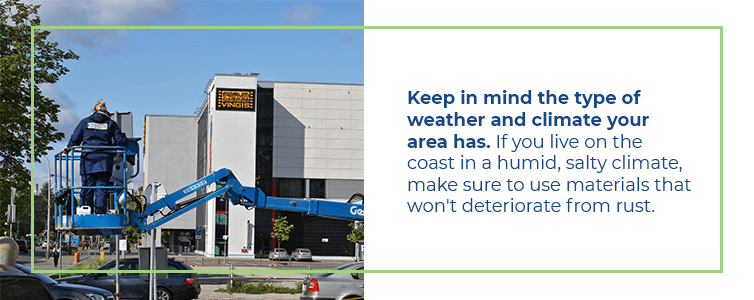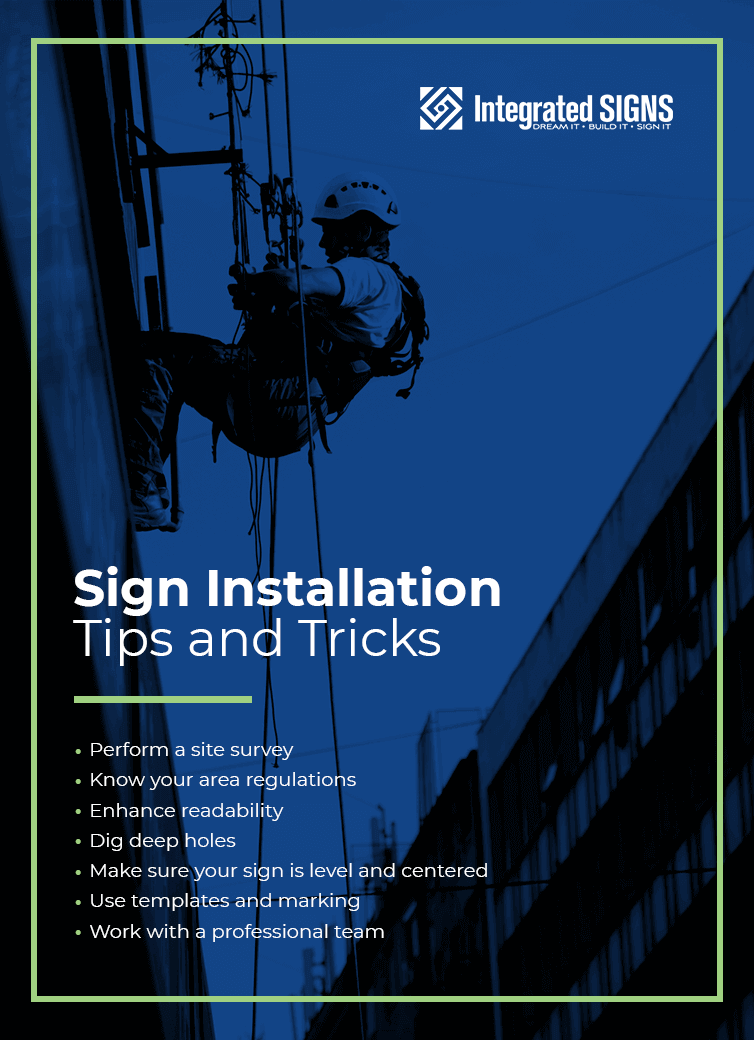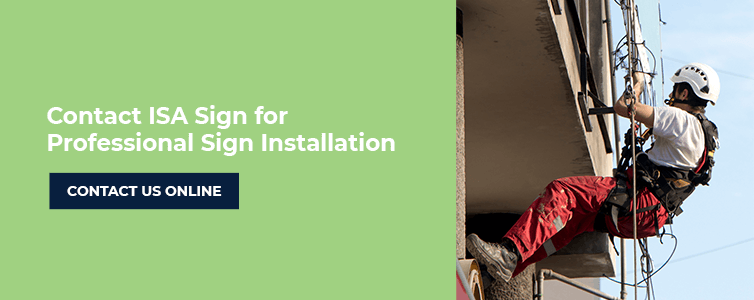- December 17, 2019
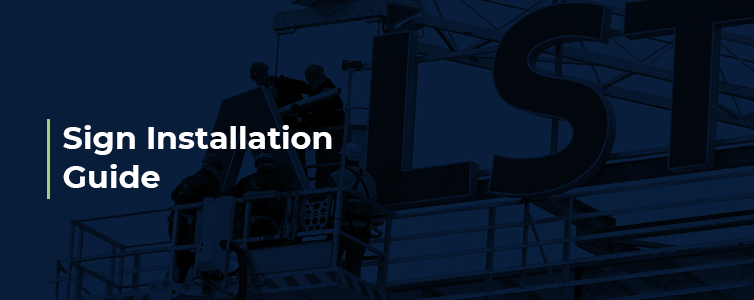
2020 Sign Installation Guide
Business signage is a powerful tool for drawing in new customers. According to one study, over 35 percent of consumers have been enticed into a business solely because of the quality of its signage — and over 60 percent of U.S. consumers have driven by a business because inadequate signage made it difficult to find.
Signs provide a bright, attractive form of continual advertising for your business. They drive traffic, convey high quality and give consumers a sense of your business’s personality and values.
However, sign installation can be a complicated process — but with the right tools, preparation and help, it can become a smooth and easy one.
How Do You Develop Signs for Your Business?
One of the most valuable benefits of business signs is the way they portray your company’s brand and values. To establish your business, you and your team have undoubtedly worked diligently to craft a powerful brand image and message. Well-made signs allow you to convey that image and message in a clear, highly visible way. To create an effective sign for your business, you’ll need to:
Make an Impression
Your signs are the face of your business. So you’ll want them to be attention-catching and unique. Especially if your business is one among many on a crowded street, spend some time thinking about how to catch new customers’ eyes.
Stand Out
A catchy slogan, a distinctive motto, a surprising color combination, aesthetically pleasing shapes, fun lighting and appealing graphics can all help your sign make a positive impression on potential customers. You can also help your business stand out by choosing a different type of sign — if all your neighbors have wall signs, for example, a three-dimensional monument sign can help you stand apart.
Emphasize Your Brand
Attracting new customers is all about brand awareness and recognition. Use your signage to make your brand familiar to your audience and give it positive associations. You can emphasize your hometown roots, showcase ways you give back to the community, highlight the quality of your products and services or promote the great customer experience you offer.
Seek Professional Guidance
When you’re developing business signs, a professional sign company is an invaluable partner. A professional company has years of experience to draw on to offer support and advice. The vision and goals can be all yours, but a professional sign company can offer ideas and provide quick responses to make the project enjoyable and smooth for everyone involved.
The team members of a professional sign company know what sizes, colors and materials would work best for your project, and they can make sure your final product is a sign you and your customers can enjoy for years.
What’s the Difference Between Professional and DIY Sign Installation?
When you’re considering installing a commercial sign, you’ll need to understand critical differences between the professional and do-it-yourself varieties:
DIY Business Sign Installation
Creating and installing signs yourself can be tempting. It can help you save money in the short term and provide a sense of accomplishment and investment in a new business venture.
But DIY sign development and installation can also lead to costly, unsightly errors. Despite your best efforts, you may end up with a crooked or smudged sign, a sign that’s impossible to read or a sign whose color combinations clash or feel outdated.
Your sign may not stand up or adhere to the wall — or it may seem fine at first but then fall apart in hot or freezing weather. Your amateur efforts will be apparent to your clientele, and potential customers may view your entire business as unprofessional.
If you end up having to redo your signs because of errors, you’ll likely lose all the money — and more — you thought you were saving by creating your signs yourself.
Professional Business Sign Installation
Sign professionals, on the other hand, create and install signs full-time. They know how different materials work and how to get your signs looking sharp, smooth and polished. They can help you design a sign that’s balanced, legible and attractively laid out, and they can make sure your sign is mounted securely with no dangling pieces or unsightly bubbles where adhesives haven’t rolled on smoothly.
A quality, professionally installed sign will also be able to withstand rain, snow, wind and scorching heat for years to come. Professional designers know which materials are best for cold, icy weather and which will stand up most durably under a blistering sun.
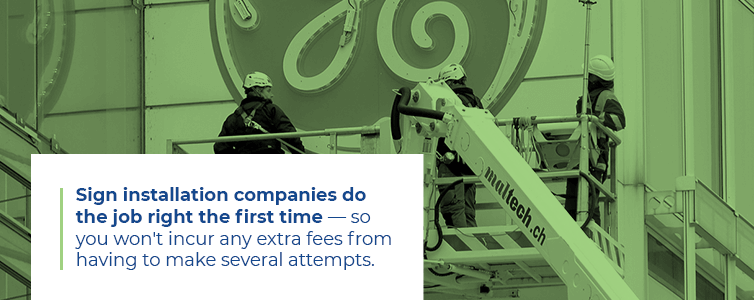
How Do You Install Different Sign Types? — Indoor vs. Outdoor
Installing indoor and outdoor signs require different considerations. When you’re installing an indoor sign, keep these factors in mind:
- Potential for seasonal updates: Generally, outdoor signs draw people’s focus to a single place: your business. But indoor signs can be used to showcase a variety of options. You can promote seasonal sales or indicate the arrival of exciting new products. For this reason, consider installing signs that can be changed easily, such as removable decals or banners.
- Power source: If your sign needs electricity to run, be sure to install it where you can connect it to an outlet easily and safely. This step is especially important for digital messaging signage and neon signage, both of which require a reliable source of power.
- Spacing: Outdoors, you might have one or two prominent signs. But indoors, you’re more likely to have a variety of signs scattered throughout your space. Especially with wayfinding signs, be sure the signs are close enough together that people following them won’t get lost. Also, consider the aesthetic balance of your indoor space, and spread your interior signs out instead of installing them all in one cluttered corner.
- Coordination: Similarly, if you have an abundance of indoor signs, you’ll want the signs near each other to coordinate well with one another. Be sure to install complementary signs near each other to give your space a polished, carefully designed feel.
- Tools: Installing a small indoor sign may not take much more than a hammer or screwdriver and a tape measure. However, be sure to have these tools handy at all times, so you can easily remove and put up indoor signs as needed.
When you’re installing an outdoor sign, you’ll want to consider these factors as well:
- Climate: Keep in mind the type of weather and climate your area has. If you live on the coast in a humid, salty climate, make sure to use materials that won’t deteriorate from rust. If you live in a hot, sunny area where the beating sun could fade or blister your sign, consider installing your sign in a shady spot to lengthen its lifespan.
- Visibility: The interior of your business is likely to be free from major obstructions, but outdoors, you’ll need to consider how to ensure passersby will see your sign. A good strategy is to choose a wall or other location that is visible from multiple angles. Make sure your sign is tall enough — or installed high enough — to be visible from down the street. One survey found that over 81 percent of potential customers become frustrated when signs are too small to read.
- Lighting: An unlighted outdoor sign is virtually invisible for the eight to 12 hours when darkness falls. But a lighted sign can act like a beacon for customers 24 hours a day. Even if your business is closed, an attractively lighted sign can appeal to potential customers and make them want to stop by at another time. Digital signage installation offers you the flexibility of tailored, changeable messaging, and neon sign installation can help give your business a homey, old-timey feel that customers will love.
- Anchoring: In an indoor setting, you may be more likely to use wall signs, decals or push-through acrylic graphics. But outdoors, a pylon sign, monument sign or illuminated channel lettering may come into play as well. How will you anchor a pylon sign or monument sign securely to the ground? For channel lettering, how will you affix the letters securely to the building? You will need stable anchoring to make sure your signs stay firmly in place.
- Safety: Outdoor signs tend to be larger than indoor signs, and they could do some serious damage if they fall after being installed incorrectly. Be sure to consider how much weight your walls and overhangs can support, and use the correct materials to keep your signs from falling and injuring someone.
How Do You Install Vinyl Graphics?
Vinyl graphics, such as vinyl wall or window decals, can be tricky to put up. Here are some helpful tips for installing vinyl signs:
- Gently clean the intended surface: Use mild soap or detergent to clean the wall or window where you want to put your vinyl graphics. Making sure the surface is free from dirt and oil will help the graphics adhere to the surface and make your wall or window graphic installation much smoother.
- Make sure your vinyl graphics are at room temperature: If you’ve stored your decals in freezing temperatures, give them some time to warm up before affixing them to the wall or window. They will stick better if they have warmed up to room temperature — and if the intended surface is at room temperature as well.
- Start at one edge of the graphic: It’s best not to remove the backing and immediately slap the decal onto the surface. Instead, choose one edge to start with. Remove the decal backing and press the exposed edge firmly to the wall or window.
- Roll the decal on carefully: Starting from the first edge, carefully roll the vinyl decal onto the window or wall. You can peel off the backing as you go, or you can remove the backing before you begin this step. Press down firmly with your fingers, and keep the vinyl as taut as you can. These steps will help avoid the creation of unsightly air bubbles or bunched-up sections in the vinyl.
- Use a squeegee: To help affix your vinyl decal more securely, as well as to remove any tiny air bubbles that have formed, run a squeegee over the surface of the decal. The seal formed by the squeegee should help squeeze out any air bubbles and make sure your decal is firmly in place.
Sign Installation Tips and Tricks
After you’ve consulted with a professional company to design a stunning sign, it’s time to install. However, there are a few things you need to consider:
- Perform a site survey: Before beginning signage installation procedures, survey the area first. That way, you can assess the topography and the street and building layout to know exactly what conditions you’re working with. Taking measurements is key — you don’t want to design a seven-foot sign only to discover that the wall is only six and a half feet wide. Many professional sign installation contractors offer a free site survey as part of their services.
- Know your area regulations: Creating and installing a sign that conforms to the applicable codes is crucial. Inside your building, you can usually decorate however you wish, as long as you keep your space up to the fire code. But for an outdoor sign, you’ll need to get a permit and comply with local ordinances when you install it. Regulations may limit your sign’s size and brightness.
- Enhance readability: Are your outdoor signs meant to bring in foot traffic, or do you want them to be legible to vehicle drivers as well? Drivers have less time and attention to spare for reading signs, so you’ll need to install a sign that’s prominent, clear and easy to read. The industry standard holds that you should add one inch to your lettering height for every 25 feet of distance from which you want your sign to be legible. Additionally, if you’re installing your sign perpendicular to the road, you’ll need to make its lettering 70 percent larger than you would for a sign mounted parallel to the road. And if your sign is intended for drivers and the speed limit outside your business is high, you’ll want to make your sign even larger.
- Dig deep holes: If you’re installing an outdoor sign where the signposts drive into the ground, be sure you get them deep enough for proper stability. If your soil is soft enough, you can drive the posts straight into the ground — ideally, at least half as deep as the sign is tall. Otherwise, you may have to drill into the soil and then backfill.
- Make sure your sign is level and centered: Even a beautifully designed and crafted sign looks awkward if it’s crooked after you install it. Make sure your sign is level and centered before you fix it in place. Your eyes may deceive you, so using a bubble level is a great way to ensure that you’ve oriented your sign correctly.
- Use templates and marking: If you’re installing a sign on an indoor or outdoor wall, try using a template that you can hold up against the wall to see how it looks before installing the permanent sign. Using painter’s tape or an erasable marker to mark the spot where the sign should go can also help you get it installed in the right place.
- Work with a professional team: If the task of DIY sign installation seems daunting — or you just want to make sure the job gets done properly and professionally — contact a professional sign company for help.
Contact ISA Sign for Professional Sign Installation
For signs you can trust to be ready on time and look fantastic for years — and for installation services that get the job done right the first time — work with Integrated Sign Associates. Our sign installation services will help your signs look great outside your business or inside.
We have the tools to handle a variety of substrates safely, from concrete to drywall, and we’ll make sure your signs are up to code and securely mounted as well. If you have a situation that calls for extreme care and precision, such as high-rise sign installation, we can help with that too.
Fill out our contact form today to learn more about indoor and outdoor sign installation.

